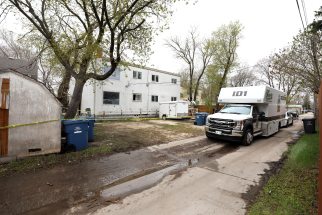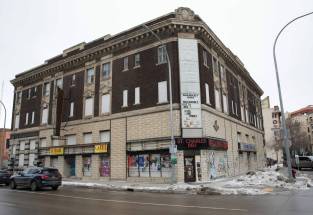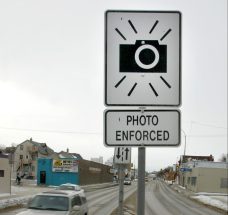Winnipeg drivers deserve photo-radar review Independent analysis would determine whether cameras make streets safer or just contribute to Winnipeg Police Service budget
Read this article for free:
or
Already have an account? Log in here »
To continue reading, please subscribe:
Monthly Digital Subscription
$0 for the first 4 weeks*
- Enjoy unlimited reading on winnipegfreepress.com
- Read the E-Edition, our digital replica newspaper
- Access News Break, our award-winning app
- Play interactive puzzles
*No charge for 4 weeks then price increases to the regular rate of $19.00 plus GST every four weeks. Offer available to new and qualified returning subscribers only. Cancel any time.
Monthly Digital Subscription
$4.75/week*
- Enjoy unlimited reading on winnipegfreepress.com
- Read the E-Edition, our digital replica newspaper
- Access News Break, our award-winning app
- Play interactive puzzles
*Billed as $19 plus GST every four weeks. Cancel any time.
To continue reading, please subscribe:
Add Free Press access to your Brandon Sun subscription for only an additional
$1 for the first 4 weeks*
*Your next subscription payment will increase by $1.00 and you will be charged $16.99 plus GST for four weeks. After four weeks, your payment will increase to $23.99 plus GST every four weeks.
Read unlimited articles for free today:
or
Already have an account? Log in here »
Hey there, time traveller!
This article was published 06/12/2022 (1104 days ago), so information in it may no longer be current.
There are many reasons why an independent review of photo enforcement in Winnipeg is needed. Unfortunately, the one announced by the province in 2019 has been put on hold and may have been cancelled altogether by the Stefanson government.
That’s disappointing, since the question of whether photo enforcement has made Winnipeg streets safer has never been objectively answered.
Winnipeg’s photo-enforcement program — which includes intersection-safety cameras and photo-radar vehicles — turns 20 next month. Police began issuing tickets Jan. 7, 2003 after a preliminary warning period the previous year.
The program has been controversial from the start. In the 20 years since its launch, no collision data have been collected where photo-radar vehicles are deployed. Where statistics have been compiled for “red-light cameras,” the results have been mixed, incomplete and almost always provided by a non-independent source: the police service itself.
JOE BRYKSA/WINNIPEG FREE PRESS FILES Winnipeg’s photo-enforcement program — which includes intersection-safety cameras and photo-radar vehicles — turns 20 next month.
When obvious flaws in the photo-enforcement program have been pointed out by citizens, journalists and the group Wise Up Winnipeg — such as the amber-light controversy — police and city traffic engineers were always quick to defend the status quo. Only when exposed in court did the city finally acknowledge that its uniform, four-second amber lights for all intersections was flawed and needed to be lengthened for high-speed routes. City officials denied they maintained unsafe amber light times to generate revenue. However, since amber times were extended in 2020 on roadways where the speed limit is 70 km/h or greater, the number of collisions at those intersections where photo enforcement is used have dropped dramatically. At three intersections measured by police (Century Street at Silver Avenue, Bishop Grandin Boulevard at River Road and Lagimodiere Boulevard at Grassie Boulevard), total collisions dropped 74 per cent from 2019 to 2021 after amber times were lengthened. Photo-enforcement revenue at those intersections also fell — which may explain why the city for years refused to change its methods. It’s a small sample size that requires more analysis. However, the preliminary findings provide compelling insight into how revenue, rather than safety, may influence decisions around photo enforcement at city hall.
In the 20 years since its launch, no collision data have been collected where photo-radar vehicles are deployed.
How else to explain why the city for the past 20 years has refused to collect crash data where photo-radar vehicles are deployed? The stated objective of photo enforcement is to reduce collisions and injuries, yet police have no evidence that photo radar has met those goals. Nor have they provided the public with a reasonable explanation for this shocking gap in evidence-based decision-making.
Police have published collision data for intersections with red-light cameras (which do not use radar technology). The results have been mixed. Depending on which years are presented, they show an increase in per capita collisions in some areas and a decline in others. When police compare the years 2002-2004 with 2019-2021 at the original 12 red-light camera locations, the three-year average shows a 22 per cent decline in collisions per 100,000 vehicles. However, the average number of right-angle collisions (T-bone crashes) for 2019-2021 per capita has increased since 2003-2004. Police tend to cherry-pick data that presents photo enforcement in the most favourable light. A more in-depth and independent analysis is required to draw more scientific conclusions.
That’s what the public thought it was getting when the Tories announced in 2019 a full, independent photo enforcement review. In order to determine whether it has improved traffic safety or has simply been a cash cow for the city, that kind of review is required.
It’s not enough for police to tell us they “believe” photo enforcement makes our streets safer. Maybe it doesn’t.
It’s not enough for police to tell us they “believe” photo enforcement makes our streets safer. Maybe it doesn’t. Maybe what we need is more conventional traffic enforcement, where motorists are targeted and held responsible for their driving records, as opposed to vehicle owners getting fines in the mail with no impact on their licence or insurance. Maybe we need better traffic engineering, including a review of amber lights and signage. All of these questions should be reviewed and analyzed in a comprehensive study before police are given the green light for more photo enforcement. The province should reverse its decision and re-commit to launching a review.
tom.brodbeck@freepress.mb.ca

Tom has been covering Manitoba politics since the early 1990s and joined the Winnipeg Free Press news team in 2019.
Our newsroom depends on a growing audience of readers to power our journalism. If you are not a paid reader, please consider becoming a subscriber.
Our newsroom depends on its audience of readers to power our journalism. Thank you for your support.












